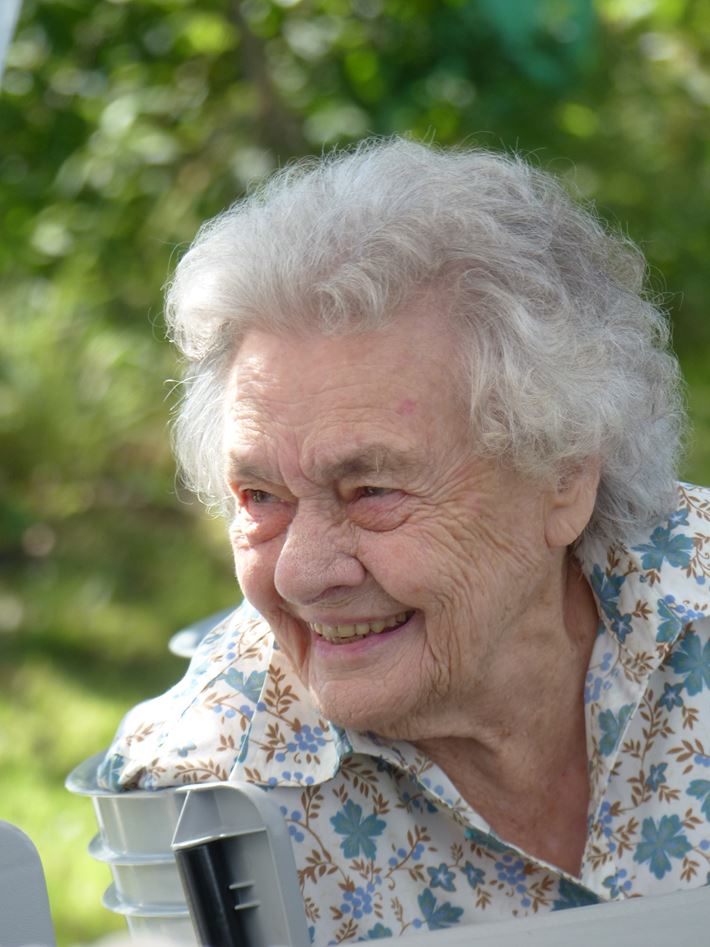Image: Margaret MacPhee in a photo taken by Terry Murray at the 84th Annual Victoria County Community Fair in 2014. A pair of her hand knit socks were sold in the Auction for $60.00 to support the Baddeck Valley Community Hall. MacPhee has never missed the event held in Baddeck Forks each fall.
~By Graham Mackenzie
Most pharmacies have at least one patient that is a centenarian. Living to the age of 100 is quite an achievement, considering these patients grew up and lived the prime of their lives in an era that had a healthcare model quite different from today. Knowledge of how diet, exercise, nutrition and medicine interplay to result in a long life wasn’t as advanced as it is today. Some may say the diet 100 years ago was superior to today’s diet. They probably wouldn’t be wrong. Sanitation, pasteurization, and crop control were also at a different stage of development.
I had the pleasure of sitting down recently with Margaret MacPhee, 103, from Baddeck, to ask her what life experiences may have helped get her to this age. In our interview, she opened up about her life from childhood to the present day.
Margaret was born at home in the winter of 1915 and grew up in a house in Upper Baddeck (Big Baddeck), the fourth oldest child in a family of 11. She wonders how she managed to be living at all growing up back then let alone survive to be 103. Her house had no electricity or phone and was heated from one central stove. Her father was a farmer and her mother “had lots to do with all the children”. This was not uncommon for families that grew up in the area, as every family seemed large. She went to school in Upper Baddeck for 11 years, then went out working from home to home in the area doing housework. She married Charles D. MacPhee in 1946 and remained with him until he passed away in 1992. The couple had one daughter, Catherine, a large difference from her family size growing up.
Margaret didn’t smoke or drink alcohol during her life and she doesn’t recall taking any type of vitamin or herb growing up. She also doesn’t directly recall most of the healthcare or medicine of her youth. Early in her life, she came down with Scarlet Fever. She doesn’t remember what Dr. Macmillan gave her for it, but she tells of being quarantined alone in her room where her mother soaked a blanket and hung it in the doorway of the room to keep the germs from spreading to the rest of the house. Given the limited sources of entertainment for children back then, it must have been a lonely time for Margaret during the long hours of her recovery. No one else came down with the disease in the house.
Margaret also had measles and whooping cough, which she recalls almost dying from. She lost a brother to the whooping cough (a twin of another brother). Another brother died from croup at just a few months old. There were no vaccines or antibiotics available for them and routine visits to the doctor were rare.
In short, childhood was a risky journey with pitfalls not seen today. Just reaching adulthood was more of an accomplishment than it is now.
When asked of her sleep habits, MacPhee says, “now I’m sleeping all the time. If I lay down at all, I’m asleep!”
As a young girl on the farm, she was up early to do chores and get ready for school. After she returned home, chores commenced again. There were three meals a day - breakfast and supper at home, while lunch was taken to school. Most food came directly from the farm. Besides home-grown beef and pork, herring and codfish were also staples. Whole foods were the norm. Processed and ultra-processed hardly existed.
Margaret doesn’t use social media. In her household growing up, they had no phone. One of the biggest differences between then and now was the direct social network everyone had. There wasn’t a night in the winter regardless of how stormy it was, that there weren’t people over at the house. Family or friends and neighbours would visit until 11 o’clock every night, often playing cards and then snowshoeing back home. If there was a storm there were no plows, but for two days after the storm everyone would be out with their horse and sleighs making a path on the road. She says there isn’t anything like this today.
We might do well by taking a lesson from the past. Today we see survival rates from some diseases like cancer increase when the patient has a better direct social network available to them.
No one reaches the age of 103 without at least one close call. One of Margaret’s earliest memories was a day when when her parents left the house to do chores around the farm leaving one of her older brothers in charge. Emerging from the barn after feeding the animals, her mother smelled smoke, soon realizing it was coming from the house and chimney. Margaret’s father smoked a pipe. Instead of using matches he would use long thin sticks lit with stove fire. Her older brother found some of these laying around, lit one and tossed it into the open chimney behind the stove containing bark, kindling, and papers. Everything in it caught fire. By the time her mother made it back to the house, Margaret’s brother had taken the younger brother out of harm’s way, leaving Margaret crawling around on the floor. Young Margaret had almost reached the blazing chimney when her mother intervened.
Today only two sisters, Agnes (Baddeck) and Marion (Sydney) are still alive. Her siblings lived to be in their 70’s for the most part. Margaret’s mother lived to the age of 99, just four months shy of her 100th birthday. She recalls her mother being hard working and believes she would have made a good nurse. She would help deliver babies, was good around animals and people. Margaret’s father passed away of a heart attack at 69 years of age.
In looking at what contributes to Margaret’s long life, we can certainly attribute her DNA passed down by her mother as being a major contributing factor. Growing up there wasn’t a lot of money to go around but like the other families in the area they got through it. They lived on whole, unpasteurized milk (not recommended today), curds, butter, cream, butter milk, vegetables and fresh farm raised meat. Today she eats a little differently - margarine and 2% milk, and some processed food she might heat up in the microwave. Aside from being forgetful with names, she is still quite active and comes into the pharmacy regularly. A good sleep habit and regular physical activity are undoubtedly helping her to age in a healthy manner. As a child and an adult, she had no cell phone to keep her up at night disrupting her sleep. Finally, a strong network of other contacts that she regularly saw reflects the results we’ve seen in longevity from other studies.
Looking back on her life, Margaret has no lasting regrets. She has also maintained a good sense of humour. When asked about how she feels about this stage of life, she recalls a story of two men in their 80’s. One says to the other how great he feels. He wakes up every day wanting to take on the world. The other one says he feels just the opposite. He feels like a baby, “I have no hair, no teeth, and I just wet myself”.
Pharmacist Graham Mackenzie owns Stone's Pharmasave in Baddeck






0
Log In or Sign Up to add a comment.- 1
arrow-eseek-eNo items to displayFacebook Comments